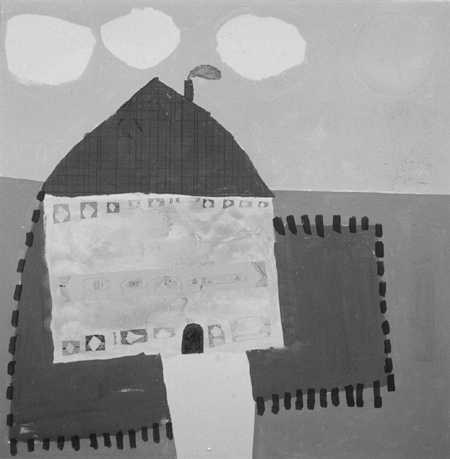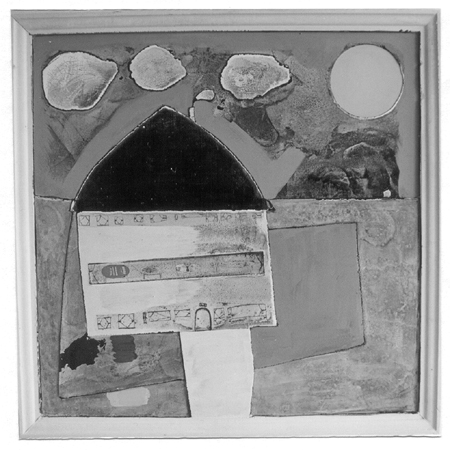In Progress: some thoughts on the notion of imprintability
As a sculptor I often work with large installations, however I also like to work in that enigmatic virtual space offered by the relief format. In a recent series of relief work titled, "How to Build a Binary House", the idea of imprintability was an important issue for me.
I have been reading Susanne Langer's book Problems of Art, and some of her observations struck a chord with me; particularly her remarks concerning our understanding of 'sensation'. Sensation would have a strong connection with 'sensability', a faculty which we all use in both producing and responding to works of Art. Since our sensibilities are individual, then our responses to works of art would also be individual and we would not always respond to poetic events in the same way.
The sensations that Susanne Langer recognizes are of a very ancient and primary order. She writes about sensations that unify the experiences of warm/cold and clear/dull, which we now differentiate as binary opposites. In her book she uses the binary pair Black and White as an example. The word black is descended from 'bhleg' and is cognate with 'blanc', 'blank', and in Swedish 'black' and Norwegian 'blakk' meaning white. What unifying sensation would connect white and black - a vast snow-covered landscape and an impenetrable dark night? Langer suggests that particular sensation is probably preserved in the word 'bleak'. The sensation of bleakness precedes and is more basic than the differentiation of white and black.
The function of art is to connect us through one of the poetic forms - Architecture, Visual Art, Music, Dance, Drama, Literature - with the dynamics of our lived, mental, sensuous and emotional lives. Works of art, as Henry James called it, are projections of felt life. When a work of art is achieved it has the capacity to draw out those deep unified sensations.
Recognizing and extending the range of one's sensibilities in both making and responding to the poetic is one of the challenges of life, so that there is a growth toward richness and maturation.
There are always some areas of artistic expression to which I readily respond. In architecture I am moved by buildings that have had multiple functional histories. In Britain, old barns, oast houses, windmills, old schools and railway stations have been transformed into, among other uses, functional living spaces. These very often seem to have an ambiance about them and are more capable of drawing out an emotive response than a custom built house. It is probably that the traces of multiple use are evident, and the tension between functions is what I respond to. After all, what is evident in these structures are binary functions - oast house/domestic home - that demand a reconciling unifying response. It is a situation in which a certain amount of flux, ambiguity, paradox and non-resolution is present and promotes reflection as a prelude to reconciliation.
In contrast I find that buildings that are stridently obvious don't elicit the same sort of response. In downtown Calgary the more recent buildings are obviously made to impress and astound; the tallest structure, the vast mirrored surface, the rising gold-clad corporate monument. I know that I should be rocked on my heels or left gasping for air, but I am not. Are the symbols too obvious, the materials used too permanent, too impenetrable, too consistent, too evidently impervious to human hands or the environment to allow a level of interactive empathy?
In the area of Visual Art making, I have had the opportunity of working with my seven year-old daughter, Mary. One thing I have recognized is that imprintability, at its basic level, is a two-way process and we both learn from each other. One painting which she made recently, My House, had qualities in it that I felt needed to be researched, and it prompted me to start the series of reliefs "How to Build a Binary House". In reflecting upon my response to Mary's painting, I recognized that there was a deep reference to organization, scale, proportion and range of mark making, which lies outside of things taught or which are seen through adult convention, as if these qualities might lie deep within some intuitive biological condition. The organization of the painting is make up of the most particular detail. The flattened, instead of foreshortened, fence. The sun divided, in the process of making, into pie segments, and inside the house a stack of cups, a jug of juice, a vase of flowers and a plate of chocolate chip cookies, one for each member of the family. It is an inclusive work.
The process I am using to make my reliefs is 'plaster printing'. Plaster of Paris, as a material, has a binary range from liquid to solid and it has an extremely wide range of possibilities in the process. I discovered the process of plaster printing in the 1960's and I have recently been researching the range of this methodology. Part of that range is the physical impritability of the material as it is being worked. Using a series of reversible plates, I am also able to deal with left/right versions of the same image, which is something I have been interested in for many years. Another potential is that of producing sequential images at various stages of the process. This allows me to explore an evolutionary element in the series, the sense of completeness of various stages. The series is just underway and many of the panels are at various stages of manipulation, but I feel that in this stage the work displays some of the qualities of the process that has been developed from Mary's original work.
When the poet Robert Graves was asked to say what poetry was, he replied, "memorable language". So, architecture would be 'memorable building; visual art, 'memorable colour an form'; dance, 'memorable movement'; and music 'memorable sound'. For poetry, in all its forms, to be memorable, it must achieve an interactive state. If we believe the implications behind the research of the theoretical scientist Niels Bohr into the ideas of complementarity, then there are no discrete properties at all and all properties are properties of interaction. Imprintability, is by definition a complementary interaction between two events, whether that interaction would be as a receptive spectator in a piece of architecture, or a dancer interacting with music through movement, or a painter imprinting ideas and feelings in the manipulation of paint. It would seem that imprintability is a necessary quality in the creative act either for a person who is a participant in the production of art or as someone appreciating it.


Zukav, Gary. The Dancing Wu Li Masters: an overview of the new physics. New York: William Morrow, c1979.
Ray Arnatt is a Professor in the Faculty of Fine Arts at the University of Calgary.